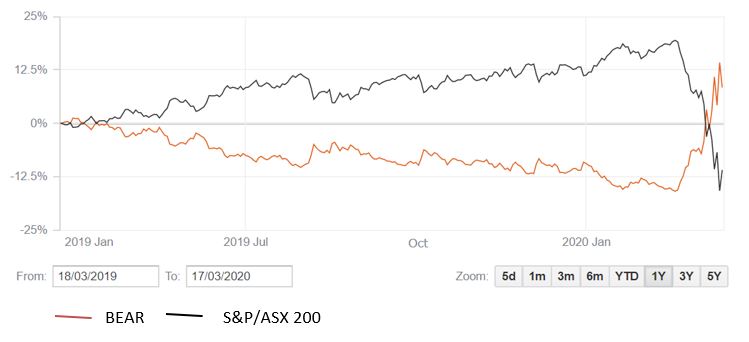Richard Montgomery from BetaShares explains how investors can position themselves to be making a return even if the market falls.
Investors are mainly conditioned to buying or selling in rising markets, with the objective of the investment going up in price over the long term, and potentially generating dividends along the way.
In falling, or very volatile markets, investors typically either sell in the fear of further losses, or sit on the sidelines and wait the downturn out. Neither of these strategies delivers a meaningful positive return while the market is falling, aside from any dividends received.
So is it possible to make a return when the market is falling? The short answer is – yes, there are ways to seek to profit in declining markets. In this article, we will look at one of those options – a type of fund available to buy and sell on the ASX, and designed to go up when the market goes down (and vice versa).
What is a Bear fund?
Bear funds are designed to increase in value as the market falls. They can be used to protect against, or profit from, declines in the sharemarket. Keep in mind they will typically go down in value if the market rises.
Some funds offer unleveraged returns – for a 1% fall in the sharemarket on a given day, the value of the fund can generally be expected to increase by approximately 1% (and vice versa) on that day.
Other products are leveraged, seeking to generate magnified returns that are negatively correlated to the sharemarket. For example, a fund might aim to produce a return of between 2 and 2.75% for a 1% fall in the sharemarket on a given day (and vice versa).
Benefits of Bear funds
ASX-traded Bear funds offer benefits over alternative methods of going short, such as selling futures or trading CFDs:You can lose no more than you invest – selling futures, for example, involves the risk of open-ended losses.
- You can lose no more than you invest – selling futures, for example, involves the risk of open-ended losses
- No margin calls
- Administratively simple – traded on the ASX just like shares
- Transparent – you can see live pricing throughout the trading day on the ASX. The net asset value (NAV) and current gearing level of your investment are available on the fund issuer’s website.
Risks of Bear funds
The main risk of a Bear fund is when the market rises your investment will fall in value.
In the case of leveraged Bear funds, there are the risks associated with gearing, which magnifies both gains and losses. Geared investments involve significantly higher risk than non-geared investments, and may not be suitable for all investors.
Certainly there are other risks to be mindful of. You should read the fund PDS and the relevant risk disclosure.
How are prices of the Bear funds determined?
Bear funds achieve their short exposure by selling share index futures contracts – not by short selling the shares in the index. Australian sharemarket Bear funds sell futures over Australia’s benchmark S&P/ASX 200 Index (SPI 200 futures), while funds offering short exposure to the U.S. sharemarket sell S&P 500 Index futures.
The prices of the Funds therefore reflect futures prices – which are not always precisely the price level of the sharemarket index. This is an important point to understand when looking at price movements in Bear funds, particularly in volatile times such as these.
The potential differences between the level of a sharemarket index and futures prices are especially relevant to a fund like BBUS (U.S. Strong Bear Hedge Fund – Currency Hedged), as the U.S. sharemarket operates in a different timezone to ASX trading hours, making it more likely that futures market movements outside U.S. sharemarket trading hours may have an impact.
What returns can I expect?
It’s important to note that Bear funds target the stated negative correlation on a given day. It should not be expected that the return over a longer period will necessarily fall within the target range, or that a Bear fund will hit a certain price at a specific Index level.
One of the reasons for this is the rebalancing that occurs from time to time to maintain the fund’s short exposure within the target range. Portfolio exposure changes on a daily basis as the market moves. If the portfolio exposure moves outside the target range, the Fund will be rebalanced to bring it back within the target range. The ‘rebalancing’ effect is particularly marked during periods of high volatility.
For illustrative purposes, the chart below shows the performance of BEAR (Australian Equities Bear Hedge Fund) against the S&P/ASX 200 Index over the 12 months to 17 March 2020.

Source: created by BetaShares. Note past performance is not an indicator of future performance.
Summary
Bear funds are designed to provide returns that are negatively correlated with the Australian or U.S. sharemarket, and so may be used to help protect against, or profit from, sharemarket declines.
It is important for investors in a Bear fund to fully understand how it operates, including how it is priced, and that it targets a return over a one-day period only. If you are considering investing in a Bear fund, be sure to review the fund’s PDS and consider the risks associated with the fund.
Disclaimers –
The Bear funds’ strategy of seeking returns that are negatively correlated to market returns is the opposite of most managed funds. Also, gearing magnifies gains and losses and may not be a suitable strategy for all investors. Investors in geared strategies should be willing to accept higher levels of investment volatility and potentially large moves (both up and down) in the value of their investment. Investors should seek professional financial advice before investing, and monitor their investment actively. An investment in any of the Bear funds should only be considered as a component of an investor’s overall portfolio.
This article contains general information only and does not take into account any person’s objective’s, financial situation or needs. Investors should consider the appropriateness of the information taking into account such factors and seek financial advice. Past performance is not indicative of future performance. Investments are subject to investment risk, investment value may go down as well as up, and investors may not get back the full amount originally invested.
BetaShares Capital Limited (ABN 78 139 566 868 AFSL 341181) (BetaShares) is the issuer of the BetaShares Bear funds.







